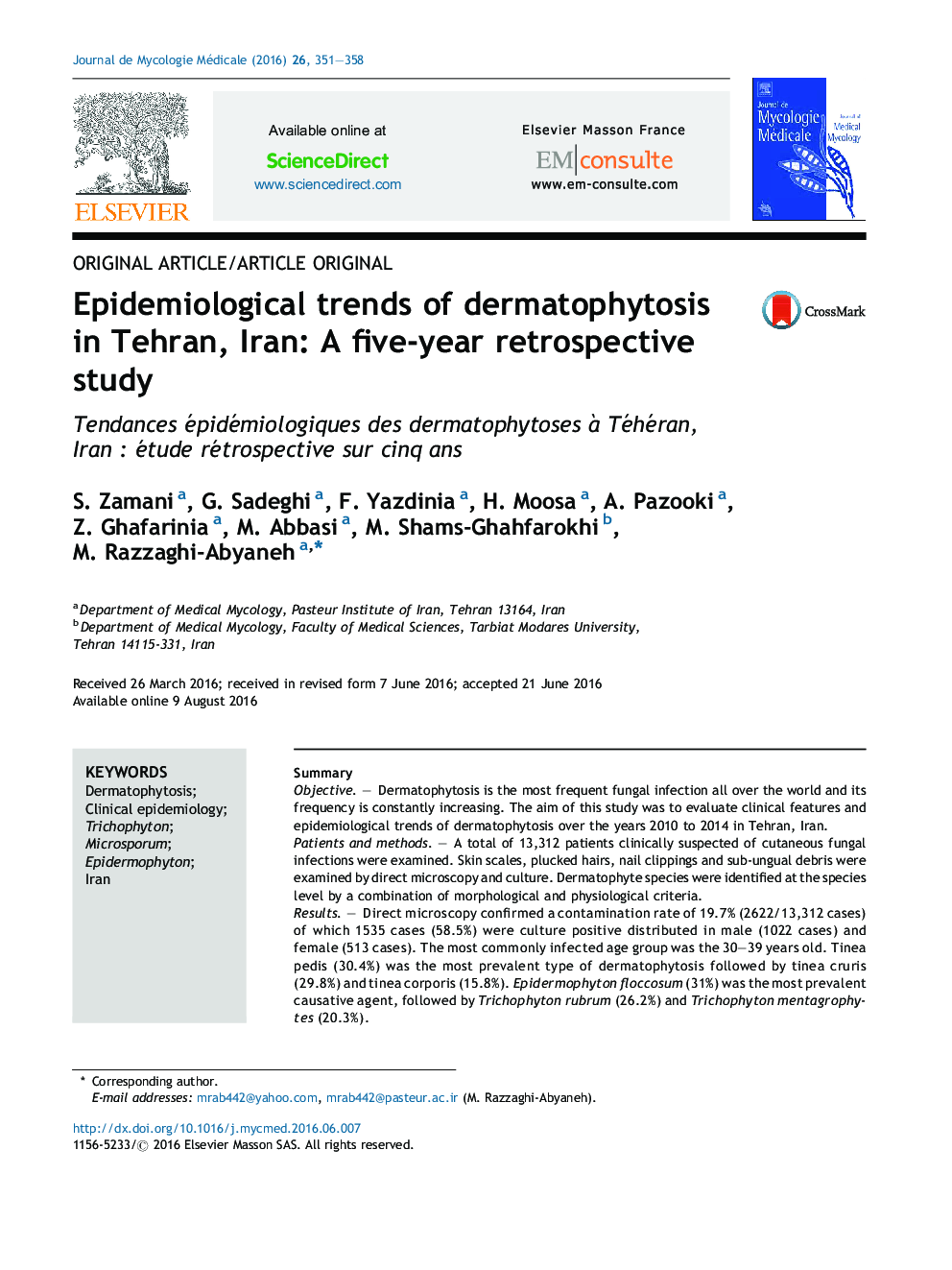| کد مقاله | کد نشریه | سال انتشار | مقاله انگلیسی | نسخه تمام متن |
|---|---|---|---|---|
| 5650047 | 1407143 | 2016 | 8 صفحه PDF | دانلود رایگان |
مقدمه
بیماران و روشها
نمونهگیری
مشاهدهی مستقیم با میکروسکوپ
کشت
تحلیلهای آماری
نتایج
جدول 1: گونههای درماتوفیت جدا شده با توجه به ویژگیهای بالینی در تهران، ایران (2010-2014)
جدول 2: توزیع درماتوفیتهای جدا شده بر اساس گروه سنی (سال) در تهران، ایران (2010-2014)
بحث
شکل 1: توزیع درماتوفیتها با توجه به جنسیت و نوع تینهآ در طی دورهی 2014-2010 در تهران، ایران. مقادیر بر اساس تعداد (n) ارائه شدهاند.
جدول 3: تعداد گونههای درماتوفیت و کشتهای ناموفق در طی دورهی 2014-2010 در تهران، ایران. مقادیر بر اساس n (%) ارائه شدهاند.
SummaryObjectiveDermatophytosis is the most frequent fungal infection all over the world and its frequency is constantly increasing. The aim of this study was to evaluate clinical features and epidemiological trends of dermatophytosis over the years 2010 to 2014 in Tehran, Iran.Patients and methodsA total of 13,312 patients clinically suspected of cutaneous fungal infections were examined. Skin scales, plucked hairs, nail clippings and sub-ungual debris were examined by direct microscopy and culture. Dermatophyte species were identified at the species level by a combination of morphological and physiological criteria.ResultsDirect microscopy confirmed a contamination rate of 19.7% (2622/13,312 cases) of which 1535 cases (58.5%) were culture positive distributed in male (1022 cases) and female (513 cases). The most commonly infected age group was the 30-39 years old. Tinea pedis (30.4%) was the most prevalent type of dermatophytosis followed by tinea cruris (29.8%) and tinea corporis (15.8%). Epidermophyton floccosum (31%) was the most prevalent causative agent, followed by Trichophyton rubrum (26.2%) and Trichophyton mentagrophytes (20.3%).ConclusionOur results showed considerable distribution of dermatophytosis from zoophilic, anthropophilic and geophilic species among population with diverse age groups. Although anthropophilic fungi such as T. mentagrophytes, E. floccosum, and T. rubrum were the main etiologic agents of dermatophytosis, the prevalence of T. verrucosum showed a meaningful increase over the years, which highlights the importance of rural dermatophytosis mainly transmitted from large animals. This noticeable information improves our current knowledge about dermatophytosis and assists to establish effective prevention and therapeutic strategies to overcome the disease.
RésuméObjectifLa dermatophytose est l'infection fongique la plus fréquente dans le monde et sa fréquence augmente constamment. Le but de cette étude était d'évaluer les caractéristiques cliniques et les tendances épidémiologiques de la dermatophytose au cours des années 2010 à 2014 à Téhéran, Iran.Patients et méthodesUn total de 13 312 patients cliniquement suspects pour des infections fongiques cutanées ont été examinés. Squames cutanées, poils épilés, fragments d'ongles et de débris sous-unguéaux ont été examinés au microscope et cultivés. Les espèces de dermatophytes ont été identifiées sur des critères morphologiques et physiologiques.RésultatsLa microscopie directe a confirmé un taux de 19,7 % (2622/13 312 cas), dont 1535 cas (58,5 %) étaient positifs à la culture. Le sex-ratio males/femelles était de 1022/513. Le groupe d'âge le plus souvent infecté était de 30-39 ans. Tinea pedis (30,4 %) était le type le plus répandu de la dermatophytose suivie par tinea cruris (29,8 %) et tinea corporis (15,8 %). Epidermophyton floccosum (31 %) était l'agent causal le plus répandu, suivi de Trichophyton rubrum (26,2 %) et Trichophyton mentagrophytes (20,3 %).ConclusionNos résultats ont montré la distribution considérable de dermatophytose des espèces zoophiles, anthropophiles et géophiles parmi la population avec des groupes d'âge divers. Bien que les champignons anthropophiles tels que T. mentagrophytes, E. floccosum et T. rubrum ont été les principaux agents étiologiques de dermatophytose, la prévalence de T. verrucosum a montré une augmentation significative au cours des années mettant en évidence l'importance de la dermatophytose rurale principalement transmise par des grands animaux. Cette information notable améliore nos connaissances actuelles sur la dermatophytose et aide à proposer une prévention efficace et des stratégies thérapeutiques pour vaincre la maladie.
Journal: Journal de Mycologie Médicale - Volume 26, Issue 4, December 2016, Pages 351-358
